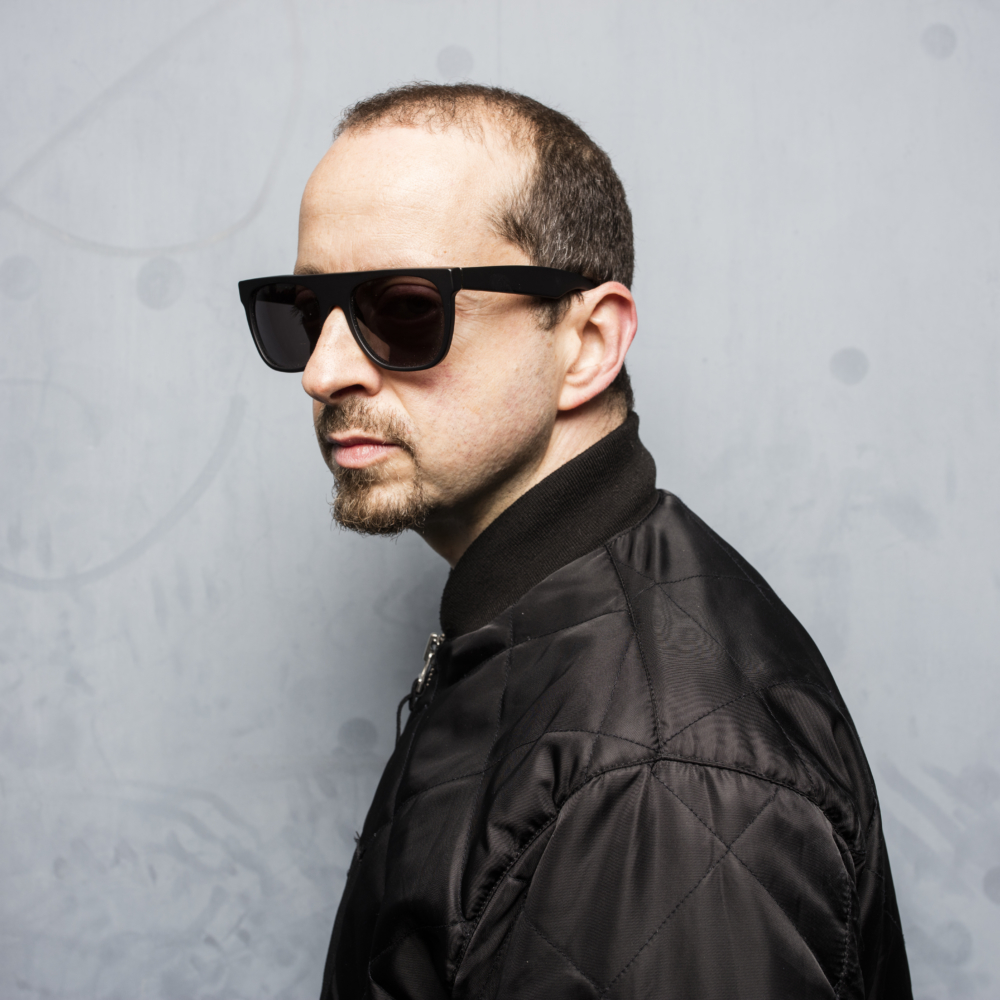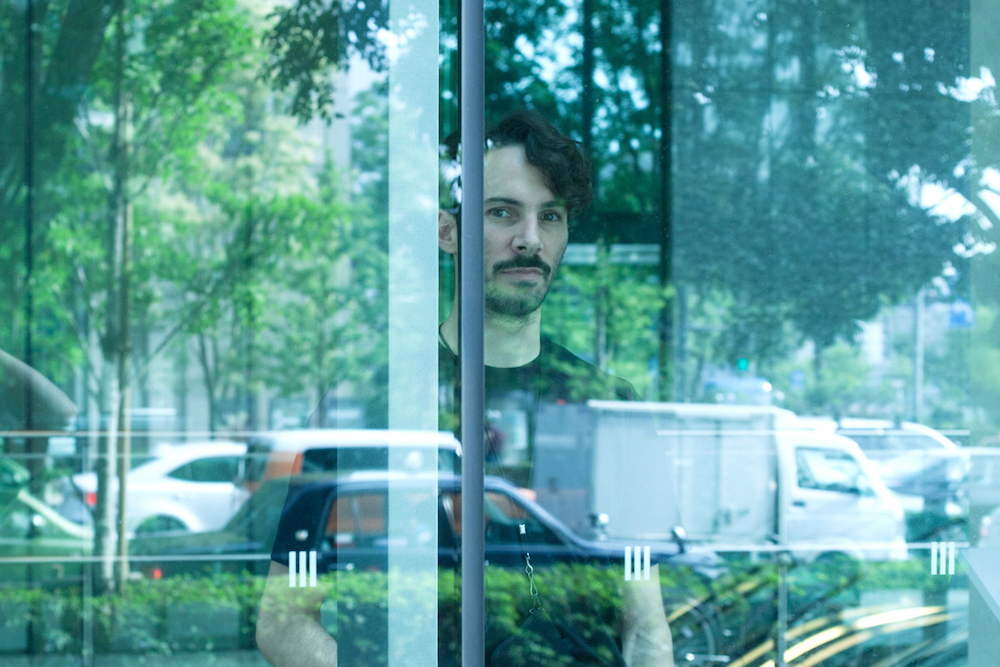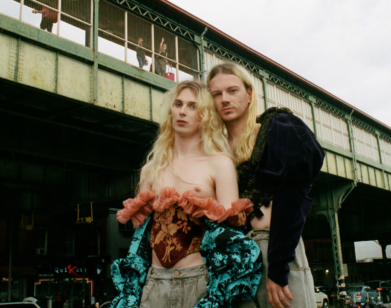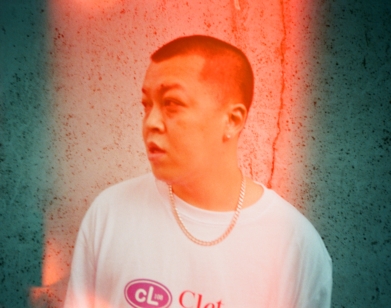British electronic legend Kode9 talks to experimental trance producer Lorenzo Senni

Italian trance experimentalist Lorenzo Senni and the British producer and Hyperdub founder Kode9, who both played at the Icelandic festival Sonar Reykjavik last month, have spent their careers exploring the outer limits of electronic sound. Senni has released several albums in which he whittles epic trance songs down to their core, removing the bass and leaving only the maximalist builds. He’s fascinated with intensity, removing trance music from the frame of the massive EDM festival experience to explore the music on his own terms. “I think I can get this euphoria outside of the usual context,” he said in a 2016 interview. Experienced at maximum volume in a sit-down concert hall, that concentrated feeling was overwhelming.
For his part, Kode9 is one of the most influential figures on the direction of electronic music over the last two decades. His label Hyperdub has put out essential releases from artists like Jessy Lanza, Burial, Laurel Halo and DJ Rashad, while his own music has included everything from sparse dubstep to footwork. His book, Sonic Warfare—a philosophical meditation on “the primacy of vibration in the nexus of sound, affect, and power”—is taught in college classes.
Few have spent more time and energy expanding the language of electronic music than these two, and their conversation is as enlightening as you’d expect.
LORENZO SENNI: When you land in Iceland, you already have something to talk about; the environment is a good starting point for our conversation.
KODE9: [We started talking] when we got into the same car at the airport. [The landscape] is just stunning and deserted. I’d seen this film a few weeks ago when I found out I was going to Iceland called Bokeh, which is on Netflix. It’s an American film. Kinda cheesy, but it’s interesting. It’s based on the idea that this American couple are touring around Iceland on holiday and they wake up one morning and it’s deserted. All of humanity seems like it’s disappeared. They go to buy food at the supermarket and they can just take what they want, and they find someone’s luxury apartment and move in there like, “Oh, cool.” And then the nervous psychic breakdown starts to unfold. So I started talking about this because we were in awe of this desolate landscape, and I know Lorenzo’s interested in sci-fi. So he told me about this book he’d read …
SENNI: Yeah, it’s a book I read years ago, The Purple Cloud [by M.P. Shiel, from 1901]. It’s about these guys that go to find the extreme north, like the Arctic circle, and crazy things happen between the captain and all the people.
KODE9: Like Heart of Darkness in the arctic.
SENNI: Yeah. They’re like, “Oh, we are fucked.” It’s one of the first apocalyptic sci-fi things. Slowly, he realizes that everyone died.
KODE9: And it was this pink gas?
SENNI: Yes, he realized that it was this smell, and pink gas cloud that was always around in this pink sky. Anyway, there are dead people and no one left, just him. He finds a girl, and then it starts something that’s more religious, like Adam and Eve.
KODE9: So it starts from scratch again? Like, humanity bootstraps itself?
SENNI: Yeah, he’s coming back and he finds this girl and they realize that it is a bit that situation.
KODE9: So yeah, we were talking about that.
SENNI: But this was just because the environment was so…
KODE9: It changes so quickly. Like the first 20 minutes from the airport you’re in this lunar landscape, and then it disappears and you’re in kind of relative normality. It’s quiet. When you’re coming straight from a city like London or New York, you’re just right in the city. It’s kind of hard cut.
SENNI: Yeah, it’s hard cut, but easier for making music.
EZRA MARCUS: You’ve been here for a while?
KODE9: No, but I’m staying until Wednesday. I’m trying to start an album, but I’m so distracted by shit in London so I thought it’d sit in my hotel room for a few days and start some stuff. So the idea of isolation and no one around appeals to me massively [laughs]. For the next few days, at least.
SENNI: It’s interesting, because it’s something that’s quite common between people who make music. To feel that they have to go somewhere. I think it’s a lot about how your brain can transform what you have around.
KODE9: Yeah, I don’t know about you but I feel like especially with an album I actually have some kind of psychic meltdown to get in the zone to do it.
SENNI: I quite recently had a discussion with another artist about the making of an album and he was like, “Oh it’s been so much fun making an album. So much fun,” and I’m like, “Wait.” I understand what you mean very deeply, but you cannot use the word fun.

IMAGE COURTESY OF WARP RECORDS
KODE9: It’s more complicated than that. Fun is part of it, but there’s layers.
SENNI: Fun is tonight at 2 AM, you know? You played last night, I play tonight. After I play this, that’s fun. But using the word fun when you make an album?
KODE9: There’s a fun part! But the hard bit is working out how to let the fun in, like the setting up the conditions for fun to happen.
SENNI: Yes [laughs]. It is a roller coaster, no?
KODE9: Retrospectively, you can say that was really fun. At the time you’re like puking everywhere, and throw up is blowing back in your face [laughs]
SENNI: [laughs] “I don’t know why I decided to come here! Who took me here,” no?
KODE9: Making music is relatively easy, but for me it’s about creating the conditions in which that fun process can happen. And that’s the holy grail. you can’t force it.
SENNI: It changed for me when I stopped drinking red bull, I swear. I’ve been addicted to red bull, honestly. Red bull was my thing. I could feel the effect of it. I’ve never been drunk in my life. I’ve never tried any drugs or smoked weed. So I don’t really know the feeling.
KODE9: [chuckles] Sorry, I’m just remembering that this then led, later in the day, to him explaining what straight edge hardcore was. I’d never heard of it.
MARCUS: Was that your scene when you were younger?
SENNI: Yeah, I was in that scene. I was not like my friends who had like, “Straight edge for life” tattooed. I was not about that. It came to Italy because of the fashion, you know? It was a way to act, a way of dressing. My very best friends were gabbers, like, proper extreme people selling drugs during high school. And during the week I was playing in a straight edge band. So in these two extremes I was wearing the bomber jacket, and that was the perfect connection. I was dressed like this twenty years ago, because the bomber jacket was good with the squatter core scene but also with gabbers. I sat between both.
KODE9: I couldn’t have even conceived of the concept, people being into heavy music of one kind and then, it’s like some kind of christian rock. I couldn’t have conceived of a subculture that that was straight edge but not moral about it.
SENNI: The biggest scene in Europe was Germany and Italy. Italy was also the biggest for gabber and hardcore. I don’t know where’s the link, but it’s interesting. Also the way people dressed was very similar sometimes. Skinheads with the bomber jacket, skinny jeans and boots.
KODE9: That’s interesting, because in the UK that cross-section of skinhead culture was in the 70s, and it was skinheads who were into reggae. And skinheads and the rude boy came together. I suppose the same thing happened in rave culture in the ‘90s when people started taking ecstasy. You’d be hugging a casual on a Saturday night in a club because you took ecstacy. So you get these convergences between subcultures.
SENNI: Yes exactly, 100%. In my area it was very touristic. Huge, huge clubs, like 7000 people.
KODE9: [Earlier this weekend] we were talking about a period when [Senni] was drinking five Red Bulls a day; you were talking about how you can hear someone’s addictions or ways of channelling, their routes into the zone, in their music. We were talking about weed and I was like well, I can tell you don’t smoke much weed from listening to your music.
SENNI: [laughs] Yeah, exactly.
KODE9: That kind of midrange, euphoric energy. Which is not a weed energy. Since I’ve been trying to wean myself off weed, my music’s been getting faster and faster [laughs]. It’s still got that down energy, though.
SENNI: I’ve been playing with this for the past few years. I did a thing at the Tate, and at the very beginning, it was just me seated in front of the computer playing build-ups of trance tracks, not my music. I was drinking Red Bull, but I was not moving, playing these build-ups, one to the other. And I was really started to get affected but I was really trying to be super static.
KODE9: Not moving at all?
SENNI: Not moving at all, just doing sometimes a few things on my computer, EQ’ing. People were getting mad because there were no drops. Not at the Tate, but [when I do this] in other contexts people get really mad. “This guy drinks red bull, but acts the opposite?” [The music] just stayed like that; the drop never happened. I was using a lot of C02 cannons. You know, [mimicking the cannon sound] “Shhhhhhhhh!” It’s a euphoria signal. Even if you don’t listen to music, you see the cannon and you go, “Oh, the drop.”
KODE9: I don’t know if you heard but I sampled compression canisters in my set.
SENNI: Yeah, yeah!
KODE9: With the C02 cannon, where you’re not sure if it’s the smoke machine going off or if it’s a military jet landing on the club.
SENNI: The smoke machine is more like [hisses] and the c02 cannon is like “SHHHH,” and you’re like “AHHHHH!” [Kode9 laughs] It’s white noise. It’s like strobe. I would use like “sh sh sh” patterns. but at the end I made the big can empty, so when it senses the pressure it’s doing a big glissando. Always moving higher. but it’s like acoustic noise. So beautiful.
KODE9: You were basically playing a C02 cannon as an instrument.
SENNI: Yes. Because it’s acoustic, and playing with the meaning of what’s in a context.
KODE9: So what kind of effect were you trying to achieve by taking all this energy, digesting all this energy, but [with] no release of the 4/4 kick drum or the drop, just building a plateau of buildups, that never dissipates. Just to cause tension?
SENNI: Yeah, causing tension, but then it transforms into something that is not tension. I was drinking red bull everyday.
KODE9: so just infinite – instead of it being a build up that crashes and burns, it’s just like… forever.
SENNI: Yeah, but then I stopped drinking five fucking Red Bulls a day.
MARCUS: One thing I thought was interesting about the dichotomy of your careers, is that, Kode9, you’ve made a career out of thinking about bass and experimenting with bass. And Lorenzo, you’ve taken bass completely out of the equation.
KODE9: [laughs] That is interesting. The set that I’ve been doing here, and this Japanese video game music compilation we released at the end of last year, and just being reminded of the twists and turns of the last ten or so years … the point at which I got bored of early dubstep [and] started to drift away from it, in 2005 or ‘06, when it was just getting really exciting and blowing up with these huge sound systems with overwhelming sub-bass vibration and so on. I was like, “Hold on.” Over a whole night this can get pretty tedious. My reaction was to try and bring some color into the music I was making and signing. The first thing I turned to was synth arpeggios. it was computer game music—I started sampling bleeps and arpeggiated runs from computer games, I signed Japanese artist Quarta 330, and then Ikonika, Zomby, Joker, Darkstar. We all had this sort of sparkly, colorful arpeggiated thing.
SENNI: Hyperdub is one of the labels I have always been following, because I added that element of you know. Of course everything was supported by the bass and everything but the melodies in the mid-high range have always been my trademark.
KODE9: That’s the difference between a normal music listener and musician or a producer, that you really make an effort to listen to stuff that your music doesn’t do, in order to compensate for your own deficiencies.
SENNI: That’s true. I care a lot about the bass, because … come on. It needs to be there, there is a frequency range that you have to respect. Some parts are important because there is something around it.
KODE9: Yeah because it’s easy to fall into a hole that you’ve dug. When you’re like, “Oh, I’m only talking about bass,” and you’ve dug that hole, and one day you just fall in. The minute that you try and learn something musically and do something different because you’re bored of yourself, people don’t like you doing that. It’s the classic story of why musicians often don’t like talking about their music too much.
MARCUS: I was thinking about Sonic Warfare, in the context of how live EDM shows like the ones Lorenzo is referencing in his work—these concerts are kind of like a weaponized assault, in a way.
KODE9: Lorenzo’s live sets are really intense. I enjoyed Lorenzo’s set, it’s true, but it’s not the only thing that’s going on. The fact that you subtract all of the pleasure buttons, and you create this infinite plateau of build-up—
SENNI: What I say, is instead of doing from 0 to 100, I do from 65 to 85 [laughs]. I think more than subtracting the pleasure, I subtract the boring part.
KODE9: You subtract the idiotic part.
SENNI: In trance, 15 years ago, the build up was three minutes, and now with EDM the build up is 30 seconds—it’s globalization. EDM is bringing this to the extreme.
MARCUS: What do you mean how globalization affects how early in the song the build comes?
SENNI: It’s like, how people buy things, how H&M produces.
KODE9: I came across this stuff on Twitter about this brostep producer who’d been accused of sexual harassment, and I just remembered last year I tweeted this thing like, “Brostep is a premonition of Trump.”
SENNI: Yes.
KODE9: I just remembered last year I tweeted, “brostep is a premonition of Trump,” because it’s got this accelerated obnoxiousness. I’ve got nothing against fast moving music but there’s something about the obnoxiousness of that style of EDM that captures something about the essence of the American spirit, being the leading edge of globalization
SENNI: This guy Alexander Iadarola, I invited him to Montreal to have a talk with me when I did this thing with the C02 cannon, because he wrote a very good article. Our brains, to come back to the music, respond to this signal. It’s a way of controlling people. If the weapon is controlling people instead of killing them—
KODE9: I think that’s what our approaches to music share is [the understanding that] you don’t just listen to music. It’s something you’re also subjected to, involuntarily. It’s modulating your nervous system and your heart rate and your skin response and all your brain waves and all of these things. Especially when you’re just using arpeggios. It’s neuro-entrainment. By taking out all those easy pleasure buttons you’re taking trance music back to what trance is, not just a genre.



